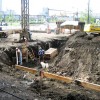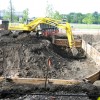Anchor Tiebacks
Video
alt="" Soldier Pile Wall with TiebacksAnchor tiebacks are the lateral support structure for a bulkhead (or wall). Bulkheads are most commonly made of steel, concrete, or wood sheet pile. Sheet piles are long flat sections of construction material that interlock longitudinally but are set vertically to form a thin wall. Marine bulkheads retain landside soils along their back face, and serve as a shield against erosion from water action along their front face. Bulkheads known as "fill bulkheads" can also be completely constructed on land. These may separate one type of soil or work site from an adjacent one, often at different elevations, or brace one side of an excavation, to provide soil slope stability. The bottom edge of a bulkhead’s sheet piles are sunk or driven into the underlying soil.
A bulkhead (or wall) can fail in three basic ways. The pressure from soils trapped behind the bulkhead can push it over. The soils, or soil depth, that the sheet pile is driven into can offer insufficient resistance to the soil pressure exerted behind the bulkhead, causing individual sheet pile elements to “kick out” at the bottom. Or, the entire system can be constructed on weak underlying soils incapable of supporting the combined weight of the bulkhead and its retained soils, causing the entire project to rotate and collapse along a plane (arc) deeper within the poorer foundational soils.
An anchor tie-back system is primarily designed to protect against the first type of bulkhead failure, holding the wall back from being pushed over by retained soil pressure. Most tie-back systems use tie-rods, which are very long and wide steel bolts, typically with threaded ends that allow them to be mechanically fastened horizontally between the bulkhead and the selected tie-back anchoring system. Sometimes tie-back cables instead of tie-rods are used. In both cases, they are usually made of galvanized steel to prevent weathering and corrosion.
Anchor tie-back systems, which the tie-rods or cables are attached to on their back end, may include “deadmen”, anchor piles, anchor walls and anchor beams. Sometimes, tie-rods may gain their strength through friction with the soil and they are not tied into a structure on their back ends. This is the case with screw-shaped helical tie-rods and tie-rods that are grouted in place.
Anchor tie-back systems are commonly buried below the surface elevation, in a line of placement parallel to the bulkhead (or wall) being supported. “Deadmen” are individual concrete or steel panels connected to a tie-rod or cable. Anchor piles can be driven vertically into the soil behind the wall, and then connected to the tie-rods or cables. An anchor wall is a short buried wall, often also constructed of sheet pile, that the tie-rods or cables are connected to. Anchor beams are a continuous horizontal member that the tie-rods or cables are connected to. Anchor beams are often used in combination with connections to supporting batter piles. Batter piles are placed in the soil behind the bulkhead at angles off the vertical, similar to an A-frame. To varying degrees, all these tie-back anchoring systems resist the soil pressure actively pushing against the inside face of the bulkhead. An assessment of all the forces acting on the bulkhead is conducted, along with the soil conditions and work dimensions at the site, and then, generally, the most cost-effective and constructable anchor tie-back system is designed and installed.

Buildipedia Staff
The Buildipedia research and writing staff consists of dozens of experienced professionals from many sectors of the industry, including architects, designers, contractors, and engineers.
Website: buildipedia.com/



